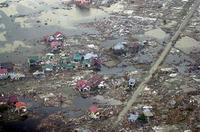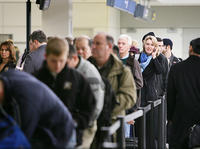-
Australia battling mosquitoes to stop spread of dengue fever

Public health officials in Queensland in northern Australia are actively battling dengue fever following an outbreak of the virus; fifty-five people have been infected in Innisfail and its outlying areas; two cases of dengue fever have been detected in Cairns, 56 miles north of Innisfail; to stem the spread of the disease, public health officials are on a campaign to eradicate mosquitos and their breeding grounds; so far the government has wiped out an estimated 50,000 mosquito breeding sites; in one week, fourteen public health field officers searched 1,117 properties in Innisfail and found 13,628 potential breeding sites
-
-
Controversy of Kansas biosecurity lab continues

KSU attracted the $650 million National Bio and Agro-Defense Facility for making vaccines and anti-virals to combat the world’s most dangerous animal diseases, beating out the competition during a multi-year screening process; in addition, KSU is planning a 26 April open house for a brand-new “innovation campus” west of Kansas City that will provide graduate level and professional science master’s degree programs (targeted versions of traditional academic programs) as well as industry training in animal health, food safety, and bio-security for more than 120 companies located in the “Kansas City animal health corridor”; critics say that building such a lab in Kansas — one of the largest livestock producing states, and a state which lies at the nation’s transportation crossroads and in the middle of Tornado Alley — is not such a good idea
-
-
Ticks identified as cause of lethal disease in China

In 2006 villagers in Anhui Province in central China began dying of an illness characterized by high fever, gastrointestinal distress, and a depressed platelet count; researchers suspected anaplasmosis, an infection spread by ticks caused by the bacterium Anaplasma phagocytophilum – but they found neither bacterial DNA nor antibodies against it; each spring since then the disease has struck with a vengeance, killing up to 30 percent of those infected in six provinces of China; scientists have now identified the enemy
-
-
Cholera outbreak in Haiti projected to infect twice as many people
U.S. researchers fear that Haiti’s cholera epidemic could be far worse than initially projected; new models estimate that nearly 800,000 people will be infected with cholera, almost double initial estimates; nine months after the 7.0 magnitude earthquake that shook Haiti last year, cholera cases began to appear for the first time in nearly a hundred years; public health officials are currently debating how to stem the spread of cholera by pursuing vaccination, antibiotics, or sanitation; Harvard researchers are advocating for the use of all three
-
-
Stemming the spread of disease at airports

With roughly two million people flying each day and spending hours in confined areas where they will come into close contact with potentially infected people, air travel poses a serious challenge to public health officials seeking to contain major disease outbreaks; last month public health officials scrambled to contain a potential mass outbreak of measles after a woman flew through three U.S airports, coming into contact with thousands of people; a CDC report recommends using infrared thermal scanners to detect passengers with fevers as that is an easily recognizable symptom and it is a common indicator of most infectious diseases
-
-
U.S. scrambling to contain potential measles outbreak
Public health officials in the United States are scrambling to prevent a massive measles outbreak after an infected woman came into contact with thousands of people as she travelled through three U.S. airports; measles is a highly contagious respiratory virus that can be transmitted through coughing or sneezing; the Centers for Disease Control and Prevention (CDC) is in the process of tracking down passengers that may have come into contact with the infected woman and closely monitoring airport employees; each year the disease kills approximately 200,000 people around the world, primarily children, but thanks to widespread vaccinations against measles, fatality rates in the United States are low
-
-
Netherlands battles to contain Q fever outbreak
The Netherlands has struggled to contain an outbreak of Q fever that first began in 2007; since the outbreak started there have been more than 4,000 confirmed cases of the disease and eleven deaths; farm animals are the primary carriers of the bacteria, and humans can become infected by breathing in contaminated air or consuming infected dairy products; after more than 2,200 people became sick in 2009, the Dutch government slaughtered over 50,000 goats in an effort to stem the spread of the disease; veterinarians and epidemiologists from around the world are watching the outbreak closely to learn more about the disease and how it is spreading; the Center for Disease Control and Prevention (CDC) had confirmed eight cases for 2011
-
-
U.S. unprepared for climate-induced disease outbreaks
Officials warn that the United States is not equipped to handle the spread of infectious diseases caused by climate change; little investment or progress has been made in bolstering disease detection and response capabilities in the United States, despite warnings from intelligence agencies; increased heat, humidity, and rainfall have caused the spread of mosquitoes and other bugs which carry deadly tropical diseases to new areas where people have yet build up a resistance; the United States is now experiencing outbreaks of dengue fever and West Nile virus; in 2010 the CDC reported 110 deaths and 1,356 cases of West Nile virus in the United States; intelligence agencies also worry about the potential for the spread of these diseases to destabilize fragile nations across Asia and Africa
-
-
New Zealand fears uncontrollable measles outbreak
Public health officials in New Zealand are racing to contain a measles outbreak that may have infected more than 300 people; measles is a highly infectious virus that can be spread through sneezing or coughing; the outbreak began with nine infected passengers aboard a flight; so far officials have identified eleven cases; two cases were from people not aboard the flight suggesting that the disease has begun to spread from person to person; out of every 1000 cases, there is typically one death and 100 hospital admissions; health officials are racing to identify people who may have come into contact with the infected and limit exposure; officials are concerned that they cannot contain the spread of the disease
-
-
A fast, simple test for detecting cholera
The new detection method uses specially prepared nanoparticles of iron oxide, each barely 1/50,000th the width of a single human hair, coated with a type of sugar called dextran; to achieve this, the scientists looked for specific characteristics of the cholera toxin receptor (GM1) found on cells’ surface in the victim’s gut, and then they introduced these features to their nanoparticles; when the magnetic nanoparticles are added to water, blood, or other fluids to be tested, the cholera toxin binds to the nanoparticles in a way that can be easily detected by instruments
-
-
Tool developed to monitor pandemic threats
An Emerging Pandemic Threats (EPT) tool, known as “Predict,” will enable scientists and the public to track outbreaks of communicable animal diseases; Predict will monitor data from 50,000 Web sites with information from World Health Organization (WHO) alerts, online discussions by experts, wildlife trade reports, and local news
-
-
Malaysia releases GM mosquitoes in landmark trial
Dengue infection leads to a sudden onset of fever with severe headaches, muscle and joint pains, and rashes, which can lead to death if left untreated; the infection killed at least 134 people last year in Malaysia alone; Malasia’s health authorities have released 6,000 genetically modified mosquitoes designed to combat dengue fever, in a landmark trial slammed last week by environmentalists who say the experiment is unsafe
-
-
Smallpox remains a large threat and issue of contention
Smallpox has been estimated to have taken the lives of an estimated 300-500 million people during the twentieth century; the last two known remaining locations of the virus which triggers the disease are the Center for Disease Control in Atlanta, Georgia, and the State Research Center of Virology and Biotechnology (VECTOR) near Novosibirsk in Russia; there is an intense debate among scientists about whether these last remaining samples should be destroyed; proponents of destruction say the remaining cultures may one day be used as bioweapons, while opponents of destruction say that destroying the cultures would not make any difference because terrorists could develop synthetic smallpox virus to use as weapon
-
-
Water test could enable post-earthquake cholera detection
There are an estimated three to five million cholera cases and 100,000 to 120,000 deaths worldwide each year; a new technique developed by University of Central Florida (UCF) scientists could allow earthquake-relief workers to test water sources that could be contaminated with the cholera toxin
-
-
Aussie "inland tsunami" now threatens Brisbane
The flood zone in northern Australia covers an area larger than France and Germany combined; incessant rain and wide-spread floods have destroyed infrastructure and severely hampered economic activity; the worst is yet to come: Brisbane river has broken its banks, sparking fears that the city — Australia’s third largest and home to two million people - will be flooded by Thursday; public health experts fear that outbreaks of Ross river virus — a debilitating disease transmitted by mosquitoes, which is endemic in Queensland — will increase
-
- All
- Regional
- Water
- Biometrics
- Borders/Immig
- Business
- Cybersecurity
- Detection
- Disasters
- Government
- Infrastructure
- International
- Public health
- Public Safety
- Communication interoperabillity
- Emergency services
- Emergency medical services
- Fire
- First response
- IEDs
- Law Enforcement
- Law Enforcement Technology
- Military technology
- Nonlethal weapons
- Nuclear weapons
- Personal protection equipment
- Police
- Notification /alert systems
- Situational awareness
- Weapons systems
- Sci-Tech
- Sector Reports
- Surveillance
- Transportation
Advertising & Marketing: advertise@newswirepubs.com
Editorial: editor@newswirepubs.com
General: info@newswirepubs.com
2010-2011 © News Wire Publications, LLC News Wire Publications, LLC
220 Old Country Road | Suite 200 | Mineola | New York | 11501
Permissions and Policies
Editorial: editor@newswirepubs.com
General: info@newswirepubs.com
2010-2011 © News Wire Publications, LLC News Wire Publications, LLC
220 Old Country Road | Suite 200 | Mineola | New York | 11501
Permissions and Policies
